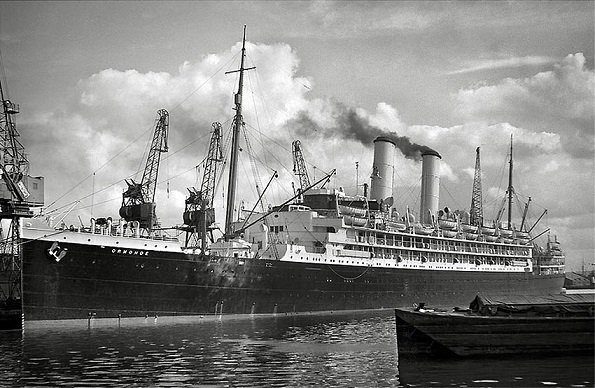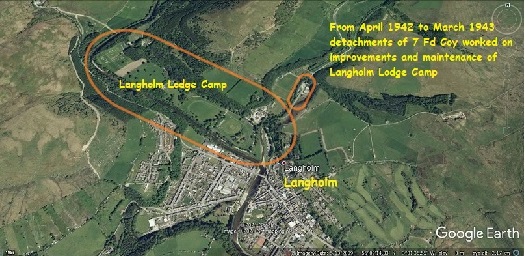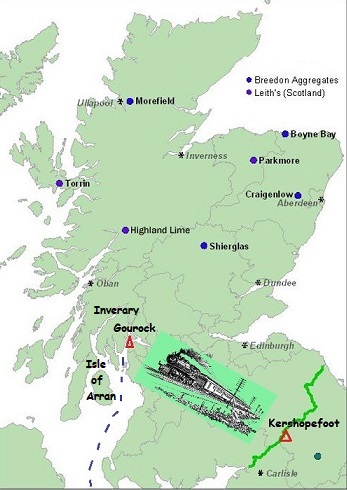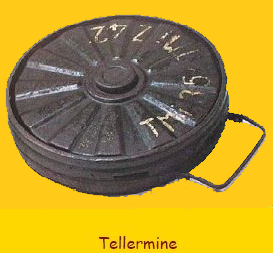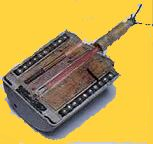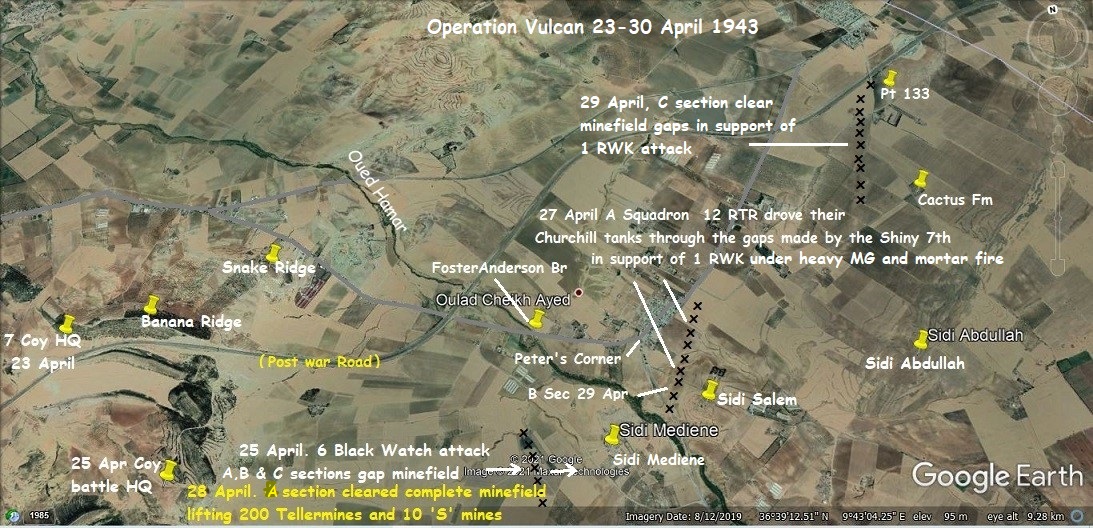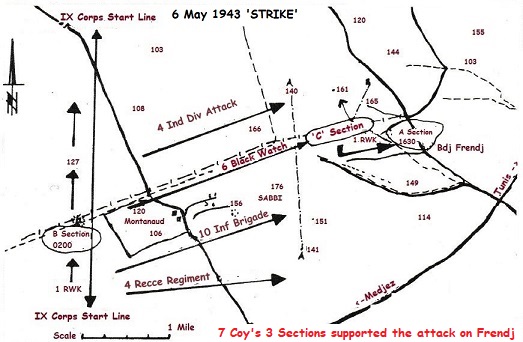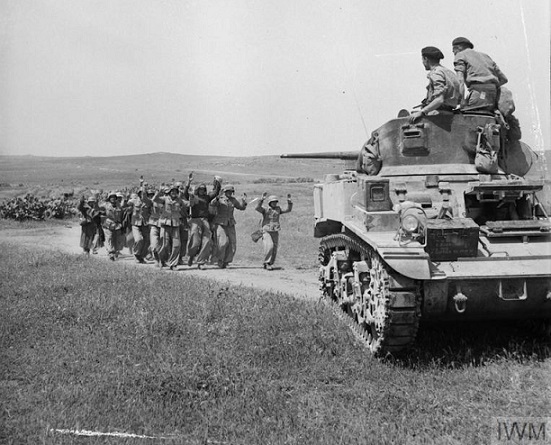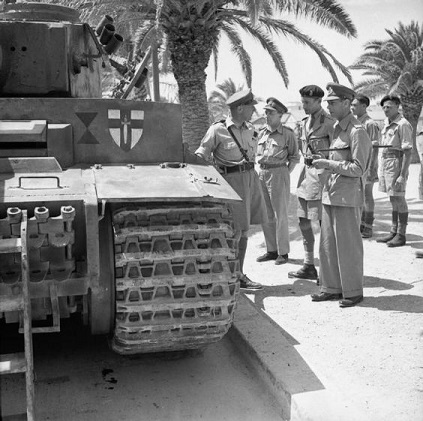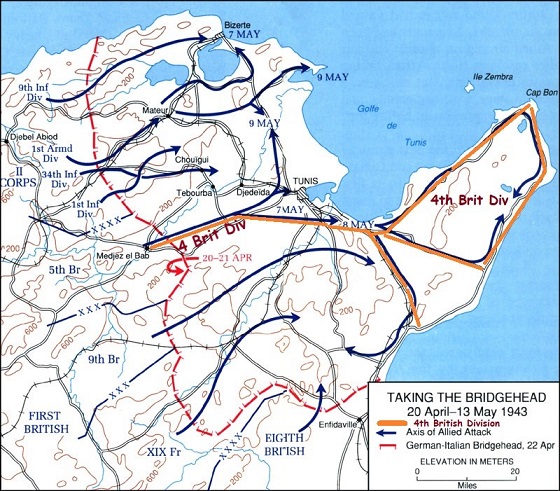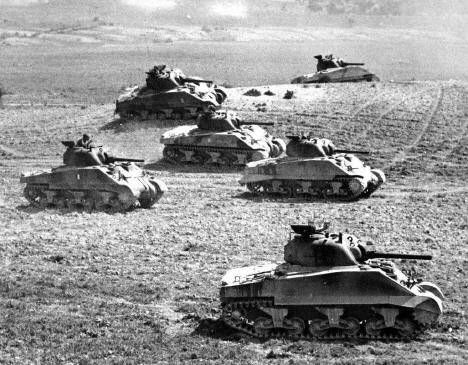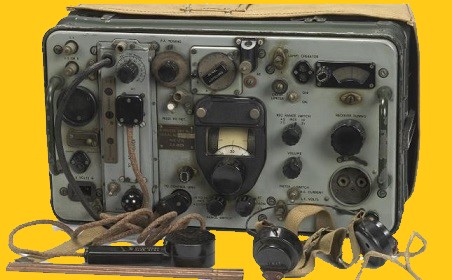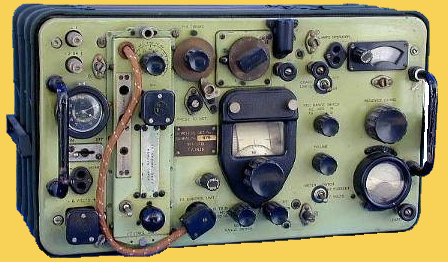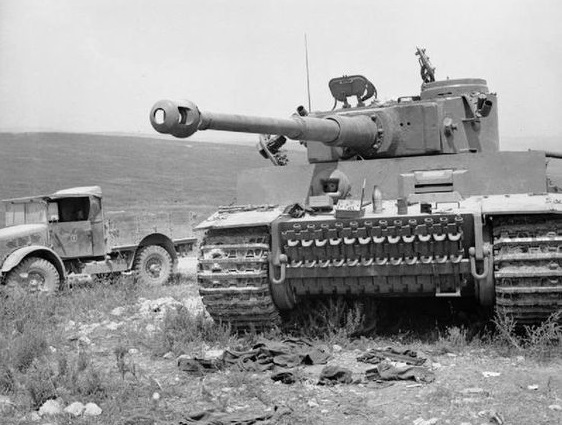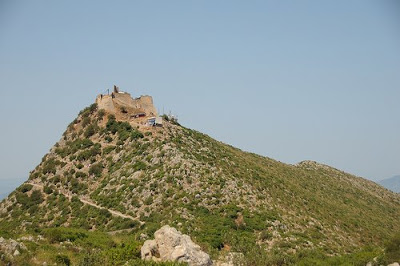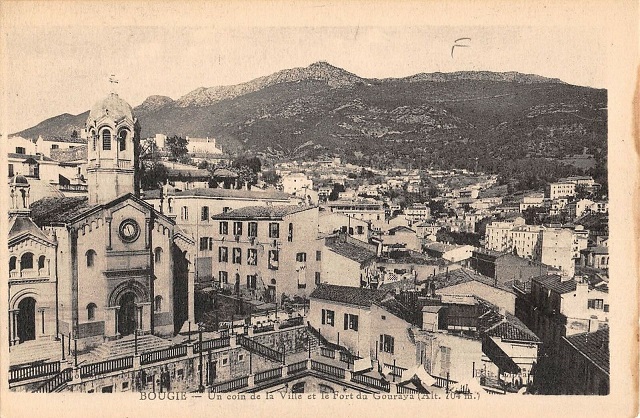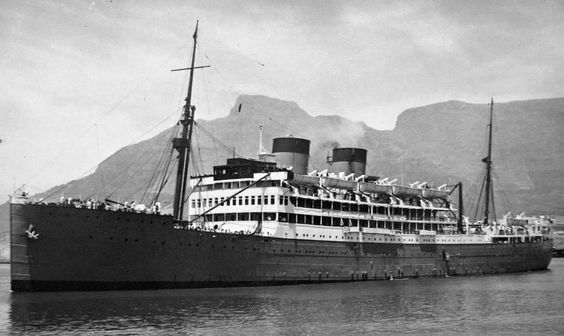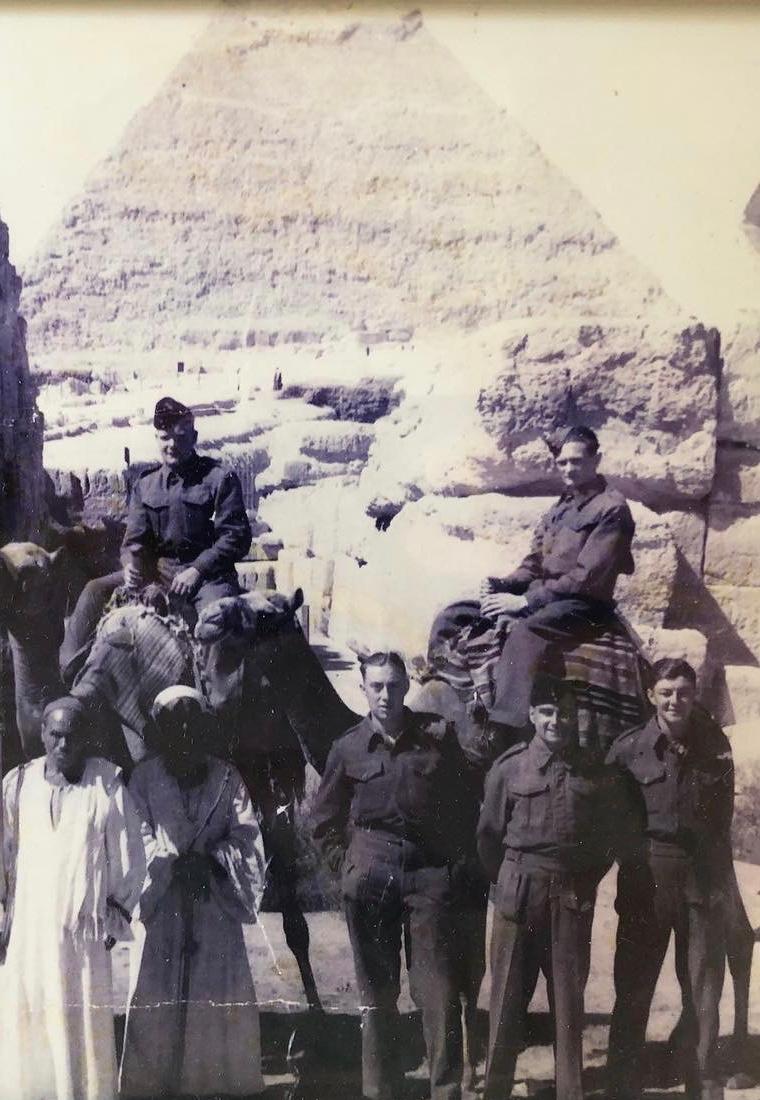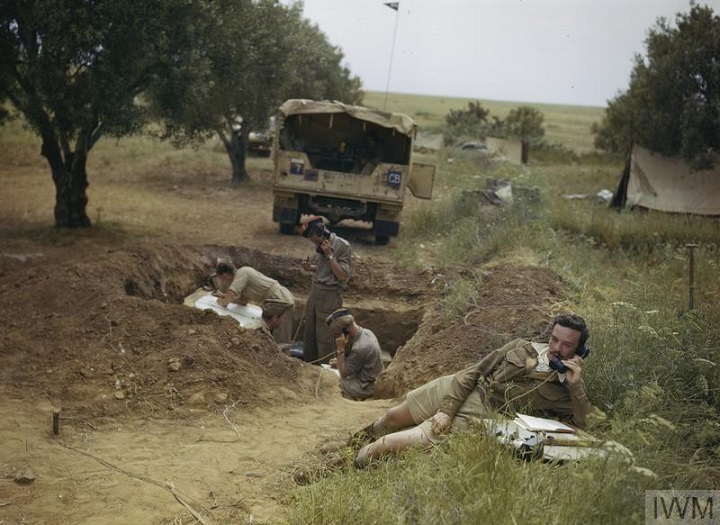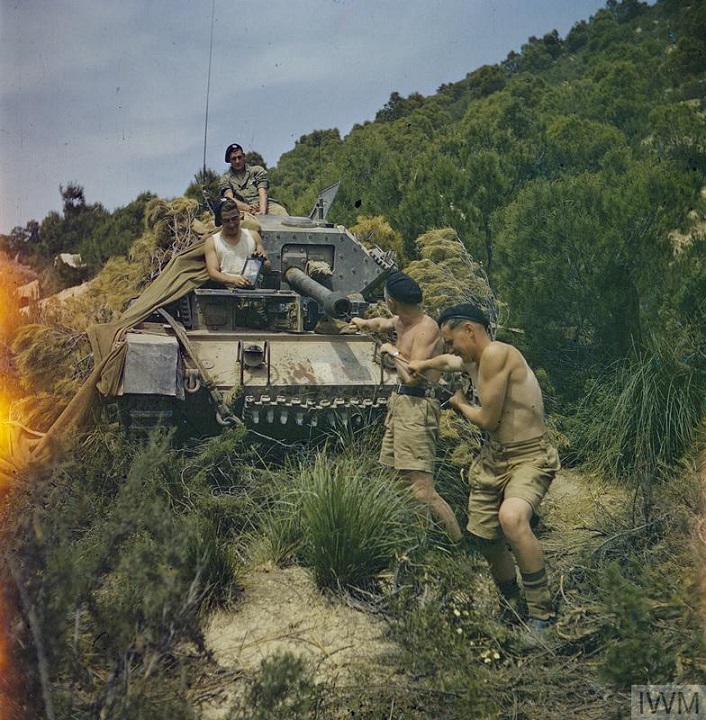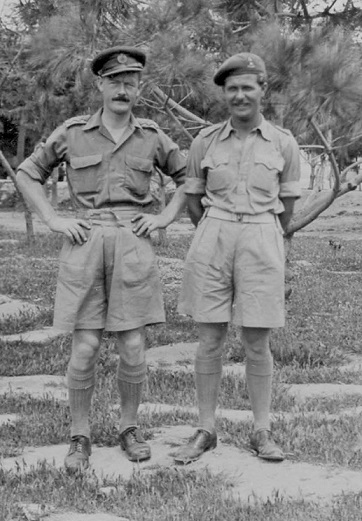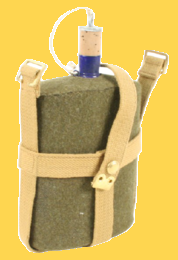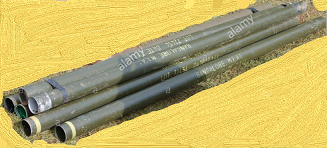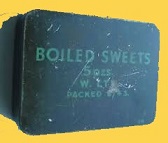7 Field Company RE 1943
Shiny 7 War Diary 1943
January. Embarkation leave was granted, and authority is given for relatives to be told that the Shiny 7 were going to the Middle East. Cooks were instructed in the culinary art of making hot dishes!
Current works were handed over to 804 Construction Coy RE. Divisional and tactical signs were erased from uniforms and vehicles, and a large 2’ yellow star within a circle was painted on bonnets of vehicles. Sections concentrated on mine warfare in all weather conditions. A lecture on the methods used at El Alamein for gapping minefields gave food for thought and led to much discussion. The MT embarked at ports on the west coast in the last week of February.
28 April. During the morning No1 Sub A Section cleared mines from the FUP for an attack by 1 RWK on Point 133 to the left of Cactus Farm. The remainder of A Section cleared a minefield at Point 103 Sidi Mediene under observation lifting 200 Tellermines and 10 S Mines. The enemy had sown S Mines around knocked out ‘Churchill’ tanks, and took great exception to the mine-clearing near the tanks bringing down a number of stonks. There was no cover, the ground was open and flat. Visibility could not have been better.
29 April Thursday. C Section put through two 16 yards lanes for the RWK attack on Point 133. One sapper was wounded by shrapnel and evacuated. During the successful attack, the poet Sydney Keyes a PL Commander in the RWK whilst advancing to the objective described ‘S’ Mines to Pte J Lucas, one of his Pl telling him, that they should keep their foot on any mine activated as it would be better for them to have a serious leg injury than to have a number of the platoon badly wounded or worse. The enemy came in with a fierce counter-attack and regained the lost ground when Sydney Keyes was killed. The objective changed hands twice leaving the enemy in possession. B Section was in support of an attack by 2 RF on Sidi Abdallah and Cactus Farm. Their task was to ensure that the lanes cleared by A and C Sections on April 27th were clear and to push another lane through the minefield for tanks. They had completed the task by 6 am when the attack began. Two sappers were slightly wounded. Despite extreme gallantry, the attacks were not strong enough to hold gains made. 2 DCLI 10 Bde were brought up to recapture Pt 133, C Section was in support making a lane for tanks by 0230 hrs the next morning.
30 April Friday. In the attack, the enemy was alerted about midnight lighting the sky with flares. ‘A’ and ‘D’ Coys took the ridge PT 133, were repulsed by a counter-attack, then took the ridge again. Tanks moved through the marked lane and were stopped by 88mm guns. At 1100 hrs the force was ordered to withdraw. Only 68 all ranks of A and D Coys reported back to 2 DCLI Bn HQ. This was the last attack by the Division on the positions around Peter’s Corner. One official report comments that in some of the most fierce fighting of the war a few miles advance had been made.
The news was sadly received that Lt Foster-Anderson had been killed the day before by an S Mine at Sidi Mediene whilst attached to the ’225’. There is no doubt that his recces of the last 10 days had saved a number of casualties.
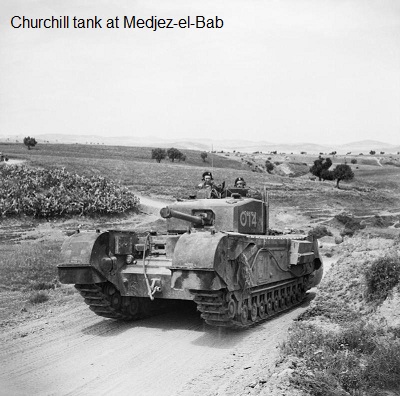
06 May Thursday. At 0130 hrs B Section moved off to the FAA to complete their task. C Section moved off with 6 Black Watch at 0230 hrs to their start line. 6 Black Watch history mentions that a Section from‘225’were in support of the Bn, no doubt a slip of the pen. At 0300 hrs the barrage opened crashing out a harsh message to the enemy from one gun a yard of the front, 16000 rounds falling on 4th Division front alone. B Section was on the start line clearing the FAA when the battle began around them and Sapper Gibbon was killed. The Section returned in time to move to a new location with Coy Tac HQ at 0600 hrs as reserve Section. C Section crossed the start line at 0345 hrs walking in four foot high corn. It was found that progress could only be made along a track, and the Section became intermingled with the Black Watch and 2 DCLI moving to another objective - 10 Bde sector with tanks of 48 RTR. Due to this C Coy 6, Black Watch attacked Pt 161 supported by C Squadron 12 RTR and a squadron of 48 RTR who were in fact in support of 2 DCLI. Pt 161 was clear of the enemy. C Section began at once to blow fox holes for 6 Black Watch to consolidate their position. L/Cpl J McNight went forward in a Bren carrier to distribute the explosive. Elements of the section moved forward under the cover of ‘Churchill’ tanks. The enemy opened up with MGs firing tracer at the ‘Churchills’ as a direction finder for their 88mm A/T guns which engaged the tanks. In this fire Spr Card was killed, Cpl Corner mortally wounded, and eighteen of the Section was wounded, this number included Sprs Atkinson, F Daly, D Fairgrave, Powell, Russel and wheeler. L/Cpl H Morris and Spr Hallam assisted the wounded, the majority of whom were flown home to the UK. Spr Coomber was saved by his belt buckle which took the full force of a piece of shrapnel. The recce party were in a PU the Section’s wireless truck the only soft-skinned vehicle in a column of armoured vehicles mainly Bren carriers. The following is the eye witness account of what happened: “ Les Mitchum was driving, I was in the passenger seat, and Wally Edwards was on set. As the only soft-skinned vehicle in the column, we felt uncomfortable listening to MG bullets whistling by. Later Lt W L Taylor was shot in the hand by a bullet from an A/T rifle situated under a tree half a mile away. I very plainly saw the shot fired, and as we had an Artillery 00 on hand it was promptly dealt with.” Lt Taylor was evacuated and returned to the UK. The Section depleted as they were, having lost close to 50% of their Sapper strength completed the job of blowing the Black Watch into position before returning to Tac HQ at 0930 hrs. ‘A’ Section moved off in semi-darkness to join 1 RWK amid a dust storm thrown up by a column of 6 armoured DIV tanks advancing on the same route. At 0730 hrs the armour was ordered to pass through the infantry. ‘A’ Section advanced on foot with 1 RWK towards Frendj at 1630 hrs. Frendj was a prominent feature overlooking almost featureless country and in the distance the road to Tunis. The infantry and Sappers advanced in extended order. Every few yards the ground was pockmarked by shell fire like a gigantic chessboard. The terrain was rocky scrub, devoid of cover. Unknown to the rank and file the enemy had fled from the immediate battlefield earlier in the day. At the objective Lt Venning distributed beehives and explosive to blow positions. A number of 88mm guns were captured with their breech blocks missing and prepared for demolition. The charges were stripped and the guns turned in the direction of the enemy ready should the breech blocks be found. Two Sappers, one believed to be Spr R.A. Awcock, were ordered to go down into a large underground room and clear it of mines etc. They went down and found two tall clean looking Germans who surrendered to the sappers much to their surprise. These were the first prisoners taken by Shiny 7 in WW2. The infantry took charge of the prisoners and the sappers went back down the cellar to carry on the good work. By 2030 hrs a party of B Section sent out to destroy a gun, which was successfully dealt with, returned to HQ at the same time as A Section. The attack was a complete success and went exactly as planned. Until May 6th the 7th had been very lucky in regard to casualties, now it had gone the other way. 4 Indian Division found that the ‘Scorpions’ were mechanically unsound and therefore could not be used.
07 May. The news came through that Tunis had Fallen.
09 May. B Section sent a subsection with a party from 48 RTR to recover knocked out tanks and the bodies in them. The job was made difficult as the enemy had planted A/P mines around the tanks, however, the job was done without any further casualties.
10 May. There was no let-up as the 1st Army pressed on to finish the job. 12 Bde headed for Korba, and 6 Armoured DIV quickly cut across the base of Cap Bon to Hammamet. This movement cut the Axis forces into three pockets, north, south and Cap Bon. 6 Armoured DIV turned south and met up with the 8th Army at Enfidaville. About 50,000 enemy were in Cap Bon, well-armed and quite capable of putting up a fight in the ideal country for that purpose. 12 Bde were directed up the eastern coastline of Cap Bon and 10 Bde Group up the Western coastline. They were ordered not to stop until they met. Twenty four hours later both Bdes met at Menzel Heuer. Cap Bon was encircled. The enemy had been given no time to organise a defence and they began to surrender in large numbers. The 7th moved at 1400 hrs.
11 May. The convoy finally arrived near Soliman on the main road at 0100 hrs. by 0600 hrs Sections were hard at work A and B Sections constructing diversions and C Section clearing a route through Soliman. Lorry loads of German POWs without guards began to appear in convoy. They were headed to a POW Camp. A band, officers in a staff car and an 88mm gun with the crew made up one convoy. it was similar to people heading off for a bank holiday break.
12 May. Capt Barron left for an airfield recce in Cap Bon.
13 May Thursday. Dvr J James the DR of Captain Barron’s party reported to the OC at 0900 hrs that the party had been ambushed. Capt Barron had been killed, Cpl Snowden mortally wounded and died in an Italian hospital to which he, and Spr A Walker the other member of the party (also wounded) were taken. Dvr James had been taken prisoner, then released the next morning (13 May). Capt Barron’s body was found and buried by Lt Hodgart. His description of the incident goes on: “As Capt Barron had been at Company HQ for almost the whole of the campaign it was decided by the OC to give him a break. He left in a captured German Volkswagon with Cpl Snowden as a driver, his Batman Spr Walker, and a DR, Dvr James. They were shot up by a large party of German paratroopers, probably Herman Goering. Along the road where John’s body lay both sides of the road were occupied by about a company and a half of these paras all armed to the teeth. I don’t mind admitting that I was nervous. However, they did not interfere or help. We decided to bury him there taking careful map reference. I am convinced that what saved us and didn’t for John was the fact that he was in a captured vehicle, and they resented that. I am sure they realised that the war was over for them. We being in a British vehicle escaped by the skin of our teeth. Even Nobby Clark admitted to being apprehensive”
Field Marshal Kesselring the German GOC in C stated that: “ All Axis forces in the north, which included Cap Bon laid down their arms on May 12th, and that the final surrender was in the ‘South’ on May 13th, and that he was in touch with his forces right to the end”. It would appear that the Field Marshal didn’t know what his forces were doing.
At 1415 hrs General Alexander reported to the prime minister:
“it is my duty to report that the Tunisian campaign is over. All enemy resistance has ceased. We are masters of the North African shores”.
Church bells were rung at home to herald the most overwhelming victory ever won by a British Commander with tremendous support from the Royal Navy and Royal Air Force. No other battle had been so decisive, and the enemy so completely destroyed. The enemy was holding formidable positions, which they intended to hold at all costs. Within one week the enemy agreed to unconditional surrender, and a quarter of a million men laid down their arms. Only 663 of the enemy escaped by air. There was no Dunkirk and shoals of small ships. The Booty was enormous but the victory in Tunisia had been won at a price. The casualties in the final battle were light for the campaign. They were:
1st Army 25,742
US Army 18,221
French Forces 19,439
8th Army from entry into Tunisia 12,348
The 7th made a short journey to Bir Drasson, a sandy fly blown location in cane groves, arriving at 1530 hrs. Late in the evening a dishevelled German soldier gave himself up to the 7th and was put at ease with a meal.
28 May. An accident occurred A Section’s location. L/Cpl Harris being killed and Spr F Shoesmith injured and evacuated. The cause was a mortar bomb of the type used by German paratroopers. It was thought that these had been made safe and not armed. The next day after a court of enquiry orders was issued that these bombs should be destroyed ‘in-situ’. The last of the Herman Goering paras were captured hiding near the coast without a fight by Cpl H Lambert’s Sub Section. They surrounded the paras giving them no option other than to surrender their arms. These troops had held Cactus Farm against the Division and still hoped to escape. There had been cases of Section vehicles being fired at, usually at nightfall.
1 July Thursday. At 0600 hrs Shiny 7 started a convoy run of 456 miles to Bougie. The purpose of the move was to train for an attack code-named ‘Goblet’ on the ‘Toe’ of Italy near Crotone to secure two airfields essential to cover any sea landing further up the leg of Italy.
4 July. Shiny 7 arrived at Bougie and pitched their tents on the beach. There was time for a game of cricket.
5 July. Four officers and 14 ORs arrived as reinforcements but the 7th was still 40 ORs under strength. ‘A’ Section started work on a Divisional Rest Camp at Djidjelli. A 48-hour leave pass was granted at the Rest Camp which was most welcome.
10 July. 2nd / Lts Blewitt, Bocker and Marks were posted to the 7th. Intensive training of all kinds was underway as well as inter-unit cricket. Swimming, shooting and engineer competitions.
18 July. Lt Corry returned to the 7th, and Lts Mckay and Venning were posted to other units. Lt-Colonel Moberley was posted as CRE, Major Griffen became OC as Major Richardson was posted as Commandant of the SME at Bone. A training project of interest was to find a solution to building BB bridges on restricted sites in mountainous country. The first idea was to build a one bay, dual carriage-way gantry with BB, then to launch as light a launching nose as possible to reach the far bank. This was not successful. An attempt was made to launch a single truss through the gantry controlled by ropes and came to grief when four or five panels collapsed. Two of B Section in the gantry luckily were unscathed. At a discussion group of officers and NCOs about the problem, one of the Sgts said: “put a tank on the back”. There were howls of laughter, but a scheme was put forward and this was the answer. Basically, a heavy tank would drive onto the first bay built with sufficient rollers to take the weight of the tank and bridge. The tank moved the bridge forward with its tracks as the bridge was built. Nothing further was heard about this until the 7th was in Egypt early in 1944. Operation ‘Goblet’ was cancelled.
3 August. The 7th moved to a wet bridging camp near Bone.
10 August. Lt Roberts was attached to 21 Tank Bde to give instruction on the ‘Snake’. It was a development of the man-powered pushing of BTs through minefields from Crawley days 1941. Tanks instead of Sappers did the pushing. There appeared to be no other development of Armoured Assault Vehicles at that time which were sorely needed.
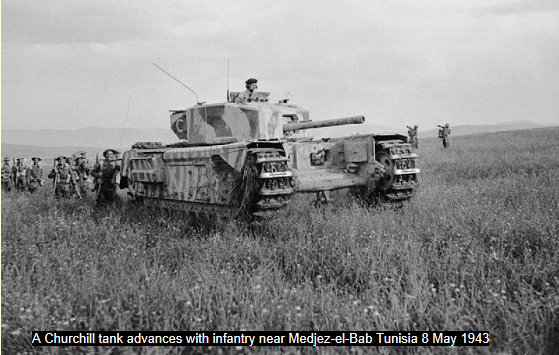
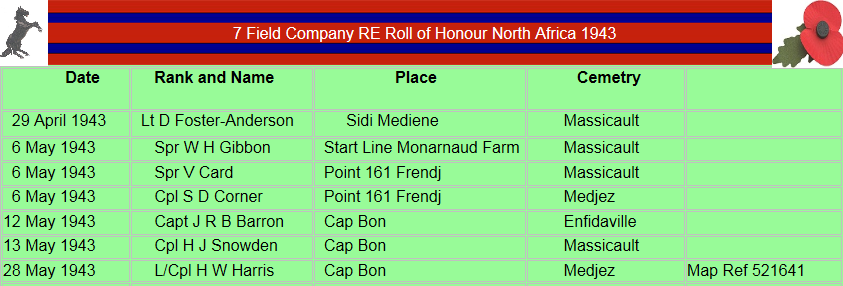
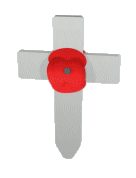
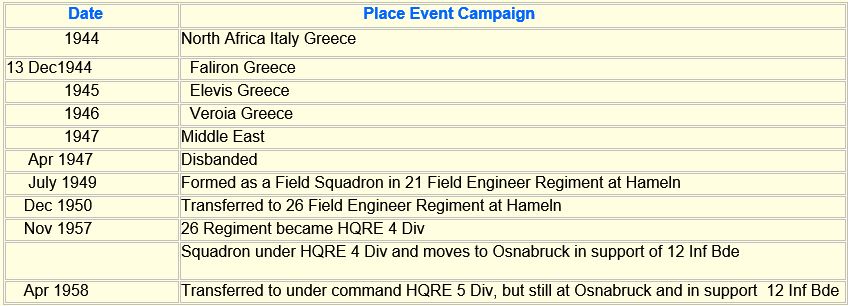
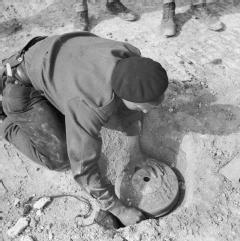
A sapper of 8 Field Squadron RE lifting a mine
on the Thala - Kasserine road 24 February 1943
HMT Ormond. This photo was taken during the war
Photograph by & © John Currin
4 April. The first contingent of the 7th left to attend a mine warfare course for training in the methods used by the 8th Army when gapping minefields. Eight-yard safe lanes were to be made initially then widened to 16 yards as soon as possible afterwards. Mine detection was either with a mine detector or prodding with bayonets. The 7th was to be employed as a specialist minefield gapping force in support of the Bde’s Tanks. The only armour provided was one scout car for the OC. Each Section was issued with a supply of mine equipment, detectors, lamps green and amber, lane markers, white painted mine hats for marking mines when detected, rolls of tracing tape, angle iron pickets and nails were the main items.
12 April. At 0900 hrs the 7th left Bone for a location near Beja. Each vehicle had its aircraft spotters sitting on top of the vehicle and vehicles were spaced at 300 yds as air attacks were expected. The convoy drove through some wide-open country onto the narrow roads of the Merjerda Mountains through ‘bomb ally’ arriving at a copse on the flat high ground approximately 1 km from Beja at 2230 hrs, unmolested from the air. The unit was dispersed under low trees. Malaria precautions were strictly enforced, shirts buttoned and sleeves rolled down in the evening. Anti-mosquito cream, mosquito nets and mecaprin tablets were issued. After a long time, very few of the Shiny 7 were affected by malaria but the yellow mecaprin tablets did give everyone a yellow look.
13 April. Sections worked on gapping drills in a live British A/T minefield on the edge of a copse overlooking wide open flat country. In the evening the 7th stood to, ready dressed in the support of an attack being made by 10 and 12 Bde on the road to Mateur through hunt’s gap. In this attack, one of the first 70 ton ‘tiger’ tanks to fall into Allied hands was captured at Sidi Neir about 20 miles NE of Beja. The enemy troops facing the Division were the Barenthian Regiment who were pushed back in a successful attack. The advance was made not without problems as the area was liberally sown with mines and booby traps.
14 April. In the early hours, Sections were stood down. They moved four miles north of Beja to two farms. A collection of mines, grenades and switches of both Allied and Axis origin were collected for individual handling. Experiments were made for a quick passage of A/P mined areas with ‘S’ mine particularly in mind, which when activated jumped about 4’ above ground level before exploding. A quick reliable method of gapping A/P mines was a priority.
15 April. The OC was ordered to form and train an MTF (minefield task force) cadre. Advance parties of infantry, CMP and Signals made up the cadre. Sections trained individually. Next day C and B Sections demonstrated in a minefield pushing through 16-yard gaps. A Signals vehicle blew up on a mine as it went through one of the lanes. Luckily there were no casualties.
19 April. The 7th moved to another location near Medjez el Bab arriving at 0200 hrs the next morning.
21 April. Thursday. 0600 hrs the 7th stood down. Sections each left a Sub Section on patrol. No contact had been made at any time though small arms fire could be heard to the north. The enemy attack had been halted then driven back. ‘A’ Section went to DIV HQ AT 1000 hrs to complete the POW cage. Signs of the battle was all around. Churchill tanks of 21 Tank Bde were forging their way up the hill as the ‘Hermans’ were withdrawing. The final result was that the V Corps attack was not held up and the enemy had lost 450 POWs and 33 of their tanks knocked out. At this time the Allies could sense that they had superiority in the air- guns- tanks and that ‘Operation Vulcan’ would sweep the Axis forces out of Africa.
7 Field Company boarded HMT Ormond at Gourock, 12 March 1943 to rejoin the war.
They disembarked at Bone, North Africa 25 March
American troops of the 34th Infantry Division landing on the beaches at Surcouf, twenty miles east of Algiers, 9 November 1942.
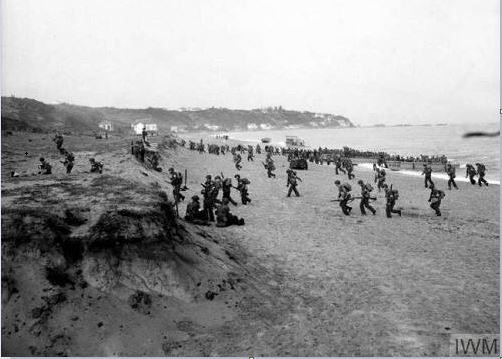
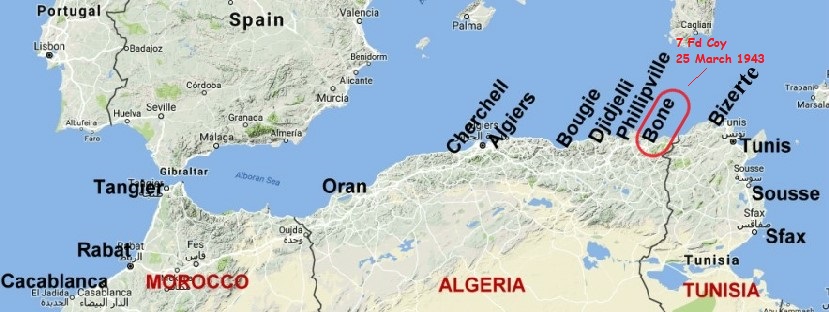
13 March. The Shiny 7 were at sea aboard ‘Ormond’, joining ships from ports down the coast to Liverpool to form a convoy of twenty-six transport ships and a naval escort of a squadron of destroyers. At sea, they settled down to a routine of meals, boat stations, lectures and PT. The physical training was supervised by PTI Busby. (later Sir Matthew Busby CBE)The Bay of Biscay lived up to its reputation claiming a number of victims, not helped by learning ‘Nelson’ was always seasick when he went to sea.
21 March. On or about this date the convoy split up. Nine ships including Ormond passed through the straits of Gibraltar during the hours of darkness. Now it was clear the shiny 7 were steaming to join the 1st Army. British, French and American forces were already there fighting since November 6th from the ‘Operation Torch’ landings at Oran and Algiers. The 7th landed in time for the third and final phase, a crushing attack by the 18th Army Group Commanded by General Alexander.
23 March. During the night two torpedo attacks were made on the convoy. Action stations were sounded. Troops sleeping on the open deck were sent down to their mess decks. In the attack, HMT Windsor Castle was torpedoed and some vehicles were lost belonging to units other than 4 DIV. At Algiers the first port of call, a number of the Company were disembarked as reinforcements to go to a transit camp.
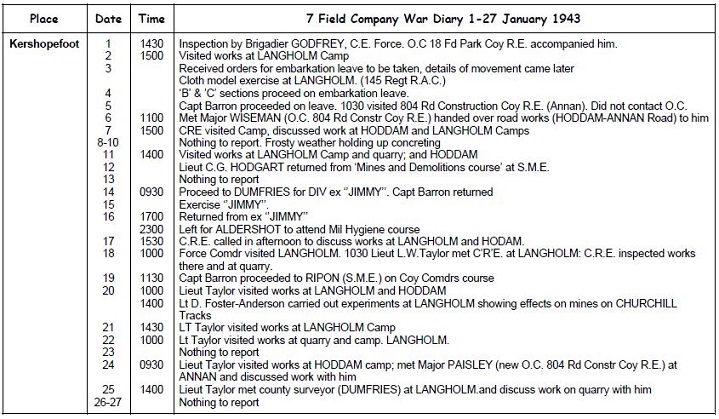

7 Field Company War Diary typed out as per how it was written
05 March. ‘A’ Section commanded by Lt Venning lined the route with elements of other units to be inspected by the King accompanied by the CIGS General Sir Alan Brooke in an open car in bright, clear weather.
12 March. At 0400 hrs the ‘7’ entrained at Kershopefoot Halt, arriving at Gourock at 1300 hrs, where they embarked on HMT Ormond, a large ship.
Kershopefoot station
25 March Thursday. ‘HMT Ormonde’ docked at Bone at 1500 hrs. Units quickly disembarked in case of air attacks. Eventually, the 7th dressed in marching order marched four miles to No 4 Transit Camp arriving there in the early hours the following morning. They soon settled down in the large tents used as accommodation. The Company strength read:
OC, Major M C Richardson. 2i/c, Capt J R B Barron. Sections: A Lt J D V Venning. B, Lt G C Hodgart. C, Lt W L Taylor. Recce Lt D Foster-Anderson. ORs 283.
Total: 289.
A busy day followed breakfast: Ships baggage and Arabs arrived.
27 March. Sections assisted the Camp commandant building Nissen huts. Training, collecting vehicles, route marches made a very quiet start to the 7th joining up with the 1st Army. One reason being it took 21 Tank Bde some time to prepare tanks after the sea journey as the floors of all vehicles were lined with sandbags to minimise injuries in the event of a vehicle hitting a mine.
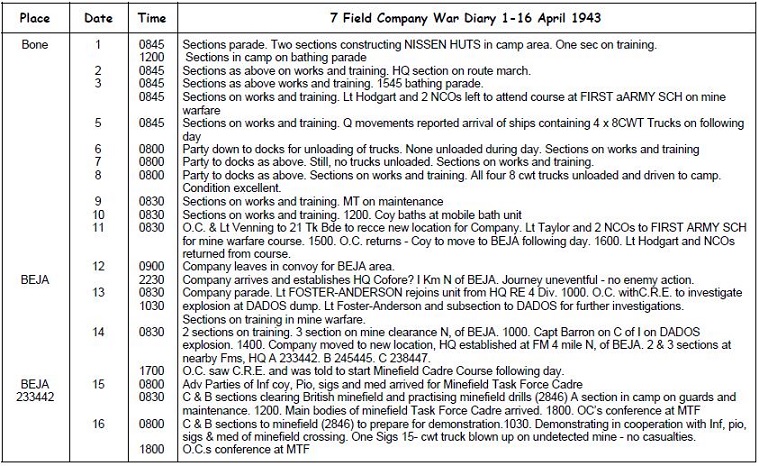
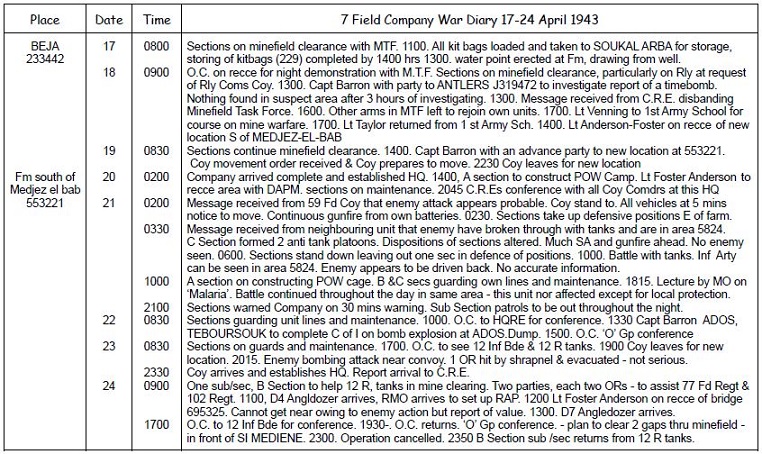
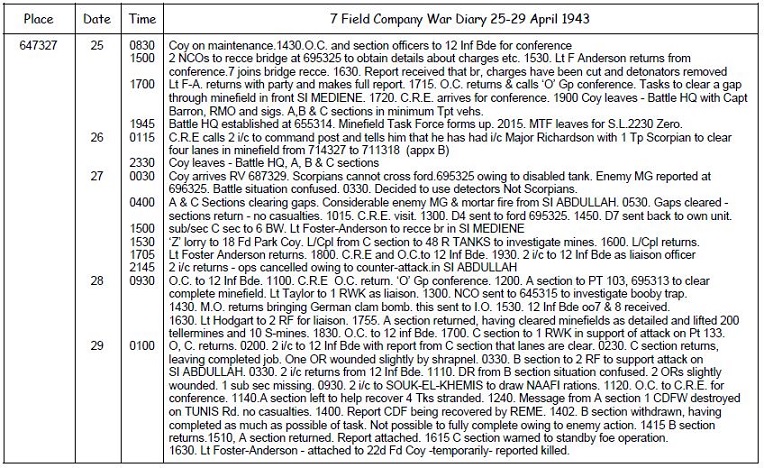

23 April Good Friday. Late in the evening, the 7th moved off. Three hours later the convoy was halted due to a bombing attack close by. One of the DRs went to the side to tend to nature. With the help of flares and other illuminations from the air activity, he noticed a sign; ‘Mines Keep Out’ they were in a minefield. Driver C Bailey driving a section compressor was hit in the leg with shrapnel. His wound was dressed and he was put in an ambulance travelling in the opposite direction. Finally, in a lull, the convoy moved off again arriving on the reverse slopes at the extreme southeastern end of a ridge known as banana ridge (Djebel Jaffa) because of its shape. Two nights earlier it was completely surrounded. The opposite side of the valley floor, burnt out German half-tracks could be seen. The 7th arrived at midnight dispersed and settled down for the night in the midst of a firework display, flares, AA fire, falling bombs and burning vehicles lighting up the sky.
25 April Easter Sunday. Lt Foster- Anderson and Spr W Turp rode off on an M/C to recce the Oud Hamar bridges on the Tunis road. ‘A’ Section would follow up with the object of being to capture at least one bridge intact. The M/C was ditched about 500 yards from the bridges. Lt Foster-Anderson covered by Spr Turp went to one bridge and in spite of enemy fire disconnected the circuit, then proceeded to remove detonators from charges on the bridge. He carried on until the bridge could not be blown by the enemy who by this time was furious with what was going on under their nose. Eventually, he withdrew returning with Spr Turp on the pillion. The only casualty was the M/C, which was drilled with bullet holes through the top of the petrol tank but was still serviceable and used until the end of the campaign. ‘225’ took on the task of clearing the bridges to make them safe. Booby traps blew charges on each bridge causing some casualties. A diversion was made across the Oued Hamar. Newspapers at home carried accounts of this incident and there is a short account in the Corps History Volume VIII. At 1715 hrs an MTF was ordered for the attack on Sidi Mediene, B and C Sections to do the job with A Section in reserve. 2330 hrs Zero Hour, B and C Sections were out of their vehicles following 6 Black Watch who made the attack in the traditional manner with their pipes playing. The objective was captured after very bitter fighting lasting 3 hours, and the repulsion of a counter-attack. It turned out that the position was held by 90 well-armed Herman Goering paratrooper s in deep trenches.
26 April. Operational contact was lost with B and C Sections. ‘A’ Section was about to be deployed to do the job but was cancelled. B Section made a 16-yard wide lane through the minefield of Mk 2 Tellermines. The first tank blew up near the entrance and C Section was ordered to clear and extend the entrance. The enemy reacted to the tanks by bringing down stonks of Nebelwerfers, six-barrel, electronically operated rocket mortars. They could fire their 80lb bombs up to four miles. These became nicknamed ‘Moaning Minnies’. Support weapons and tanks passed through the minefield gap on to the objective before dawn to assist the 6 Black Watch fight off a second counter-attack. The MTF returned to Banana Ridge unscathed. Orders were received to support an attack that night by 1 RWK, and a silent attack would be made by ‘A’ Company on Sidi Salem Point 112 and ‘B’ Coy on Sidi Abdallah point 137. Their objectives were on the line of hills NE from Sidi Mediene overlooking and guarding the Tunis road. The 7th would have No1 Troop Scorpion flail tanks, RTR in support. A and C Section would make one lane each 16 yards wide through a minefield in front of Sidi Abdallah from the direction of the Tunis road. Sections would be prepared to clear the gaps by hand if for any reason the Scorpions were unable to do so. B Section was in reserve, in the afternoon, they trained with the Scorpions at Banana Ridge. The MTF left at 2330 hrs arriving at the RV on the Tunis road near Peter’s corner on the slope running down to the ‘Foster-Anderson’ bridge, timed as midnight.
27 April. The night was dry and clear. For three and a half hours the MTF sat in their vehicles looking at the battlefield on their right. ‘A’ Coy, 1 RWK captured Sidi Salem after a hard fight. The enemy came in with a strong attack on Sidi Mediene with flame throwers and was beaten off by the Black Watch. The whole area was lit by flares, tracer, explosions from grenades and mortars. By 0330 hrs time was short if the lanes were to be completed by dawn. The mines in front of Sidi Abdallah had upset B Coy’s attack in an unexpected manner, Coy’s compasses were affected, direction lost and the OC decided to halt and wait for a day before making the attack. The 7th would therefore be going into uncharted country, not for the first time. A and C Sections prepared to clear the gaps by hand because the ‘Scorpions’ were unable to cross the Oud Hamar diversion. It is odd that every conceivable type of vehicle could cross except the ‘Scorpions’. One explanation at the time was that they must not be seen in daylight. Lt Foster-Anderson went forward and recced the minefield and the location of the points where the gaps were going through. The MTF facing the objective with A Section on the left and C Section on the right, some 200/300 yards apart. The Sections went forward to make the lanes, A Section using detectors and C Section using bayonets. The minefield consisted of four rows of Mk2 Tellermines running parallel to the line of hills. Dawn was breaking and the mist lifting up the slopes of Sidi Abdallah, and nearby MGs (Spandau) were beating out a message with a stream of fire close by from left to right across the 7th’s front. Work was speeded up and risks taken to complete the task. The work was completed in record time and the Sections returned to Banana Ridge none the worse for wear. ‘A’ Squadron 12 RTR drove their ‘Churchill’ tanks through the gaps made by the Shiny 7 in support of 1 RWK. The tanks reached their objective Sidi Abdallah, however, the infantry was held back by fierce MG fire. The tanks held on reinforced by A Coy 6 Black Watch, the force was pushed back by a counter-attack with ‘Tiger’ tanks. In the next few days, Sidi Abdallah changed hands eight times. Each time the infantry and support weapons took the objective they were not strong enough to hold on.
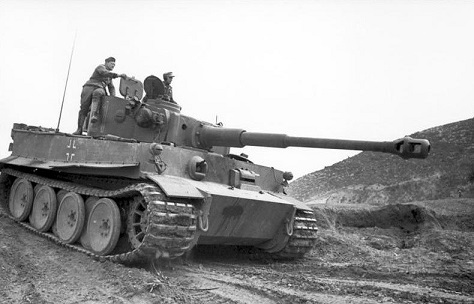
Photo: Bundesarchiv_Bild_101I-554-0872-35_Tunesien_Panzer_VI_Tiger_I
Right: IWM Photo N.A,442.
8 Field Squadron RE part of
6 Armd Div working on a road
and a Bailey bridge near
Medjez-El-Bab. 1943
On the 28 April 'A' section was tasked to clear a minefield at Pt 103 GR 695313. They cleared the minefield and picked up 200 Tellermines and 10 'S' Anti-Pers mines
S Mine
Tiger Tank in Tunisia
An IWM short clip of Churchill tanks in action near Banana Ridge
https://youtu.be/HRb3-62uzx8
IWM photo. Taken by Lt Whicker. (Alan Whicker)
Scorpion Flails mounted on a Matilda tank and used in Tunisia.
7 Coy was in support of 21 Tank Bde when they cleared minefields with Scorpion.
29 April 1943.
Lt Foster-Anderson a hard-working and courageous officer was killed by an 'S' mine at Sidi Mediene while on temporary detachment to 225 Coy. R.I.P.
Photo taken in UK 1942
Photo,IWM N.A. 2514. Germans surrender to one of our tanks at Frendj
2 May Sunday. It was something to go to a mobile shower bath unit and clean up in readiness for the issue of KD the next day. NCOs appeared with chevrons on the right arm only held in place by the elastic band from a pair of eye shields. The yellow vehicles of 8th Army began to appear at Medjez amongst the camouflaged trucks of 1st Army. Generals down to the grassroots of the 8th Army had their condescending say at the time and when writing of the period later. The 7th for their part whilst officially resting were busy looking for a solution to the problem of blowing positions for the infantry once an objective had been taken and before a counter-attack could be mounted. Digging was a non-starter due to the rocky nature of the terrain. Sections found the best method was to use ‘Beehives’ to blow holes and then made up charges in ‘Jam’ tins were placed in the holes blown by the ‘Beehives’ and ‘Foxholes’ could be very quickly made. After trials, this method was adopted. After a flight of ‘Focke-Wulf’ aircraft attacked the Medjes area. It was reported that Spr E Mann assisted in bringing one of the aircraft down on Banana Ridge with his Bren gun from his swivel seat on a 15cwt truck. This was one of the very few day-light attacks made, and from this time onwards air attacks were made at night.
03 May Monday. At 0630 hrs B Section went to assist ‘225’ camouflaging 4 DIV GOC’s battle HQ for the forthcoming attack ‘Operation Strike’. This was placed in front of the leading infantry 1 RWK guarding the start line of 3000 yards to be used in the attack by the Division and 4 Indian DIV. A Sub Section of ‘A’ Section went to assist a US Army Signals Unit and cleared a mine infested area in Medjez el Bab of A/Tm and A/Pm. The mines were British, American and German dug into the ground, attached to telegraph poles and fences, some with a number of tripwires (necklace). The job was safely completed during the afternoon in time to join C Section in a night exercise with ‘Scorpions’ bringing to a high pitch the teamwork of gapping minefields. The use of ‘SLUG’ had made the ‘Scorpion’ a 100% mine clearer its flails dealt with the A/tank mine and ‘SLUG’ A/pers mine.
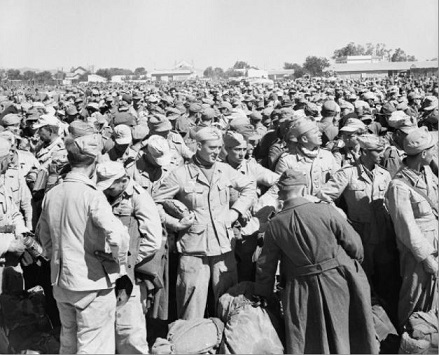
Axis Forces POW Camp at Gromalia after the fall of Tunis May 1943
04 May. The ‘Scorpions’ left to join 4 Indian DIV not to be seen again during the war by the 7th, more to the point ‘SLUG’ disappeared from the scene for good. The day was spent ‘Make and Mend’, checking equipment, preparing jam tin charges, tuning detectors ready for last-light.
Alexander made this clear years later in his Basil Hicks lecture at Sheffield. ‘Monty’ described the 1st Army attack, as a “Partridge shoot” forgetting that 8th Army fared no better once they reached the Tunisian mountains at enfidaville. The Allied plan was that Africa must be cleared by mid-May so that ‘Huskey’ the assault on Sicily could go ahead. The huge superiority of the Allies on the sea, in the air, and on the ground ensured that the fate of the axis forces was sealed and this force was about to be concentrated in a crushing attack planned by General Alexander called ‘Strike’. 4th Indian and 7th Armoured DIVS and 201 Guards Bde of 8th Army were moved to the Medjez sector. They with 4 DIV and 6 Armoured DIV would form IX Corps commanded by Lt-General Crocker. He was unfortunately wounded demonstrating a PIAT, a new infantry A/T Weapon. Lt-General Horrocks took command of IX Corps. Lt-General Allfrey’s V Corps would hold the outer ring demonstrating and would take the last heights known as the ‘Bou’ with 1 Div north of Medjez.
05 May. At 0710 hrs ‘Shiny 7 left their rocky patch on Banana Ridge and moved NE of the Tunis-Medjes road in open rolling country. In the late afternoon, ‘O’ Groups were held. The 7th was in support of 12 Bde. Operation ‘STRIKE’ would commence with 600 guns firing at 0300 hrs May 6 the next morning. B Section would clear the FAA on the start line held by 1 RWK. C Section would support and blow 6 Black Watch into position on their objective Point 161 Arg el Hadjar. ‘A’ Section would support 1 RWK blowing them into position on the Division’s last objective Frendje. C Section left at 1545 hrs to join 6 Black Watch, Spr Bevin was injured when a piece of flying rock struck his head whilst C Section was experimenting blowing fox holes. He was not evacuated but out of the battle.
On the beach at Cap Bon
Sub-Section 'A' Section.
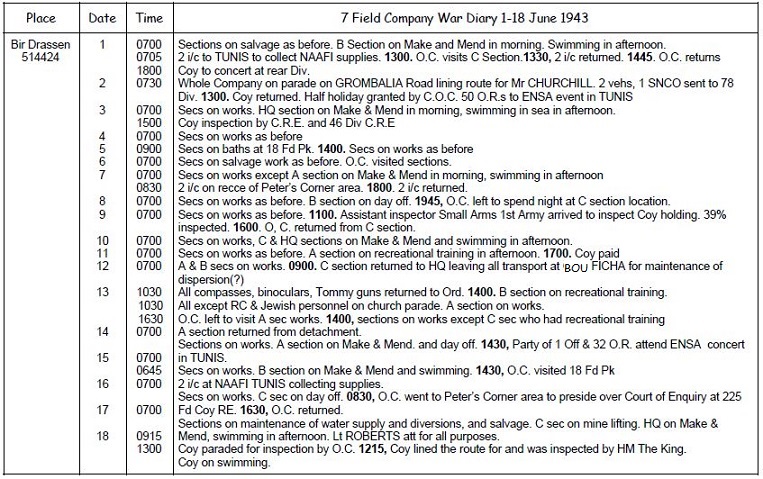
2 June. Shiny 7 paraded lining the Grombalia road for the Prime Minister and the CIGS General Brooke.
Work continued in the area setting up water points and mine lifting. Lt Roberts was posted from the ‘59’.
18 June Friday. At midday, the 7th lined a road in the area for inspection by the King who as always looked very smart and fit. The dress was KD Shorts (the 7th were in the process of getting ‘their knees brown’) and sidearms. Training got underway again, bridging schemes, water points, and general engineering using all equipment, lashings etc. A sign that another operation was pending. Lt Mckay was posted in from the ‘225’
30 June. Preparations were made for a move near to Bougie the next day. Tents were struck. One of the priorities of the last few weeks was to salvage sufficient enemy tents to ensure that the whole unit was under canvas. Eventually, all captured MT and weapons were handed in.
The Tunisian campaign was over and the 1st Army ceased to exist. General Anderson was ordered to the UK to command 2nd Army forming for the 2nd front.
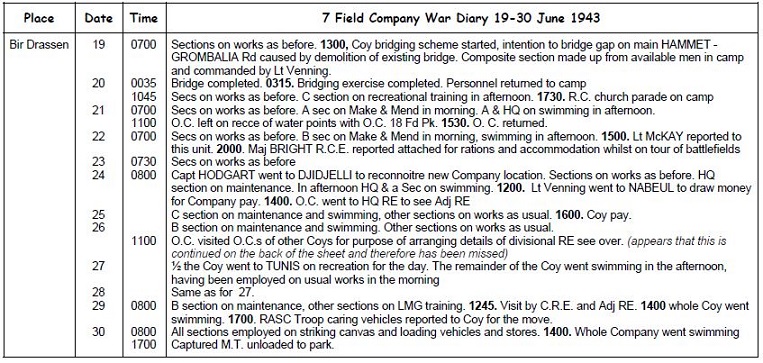
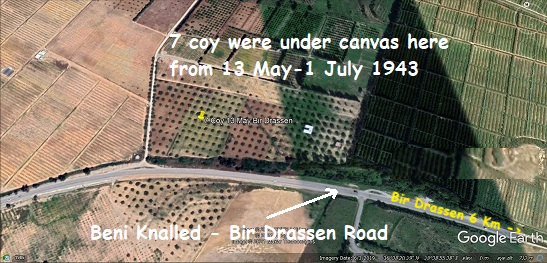
1 November. The OC, Major Griffin was posted. It was doubtful if the 7th would ever get a taller OC. He was 6’ 9” and towered over everyone.
5 December. Warm clothes at last. Battledress was issued, and the next day Major Low arrived to take command as OC. He was a mountaineer and ex-commando. Lt Smart aided by a few willing assistants and a battered piano as the only musical instrument available began to produce a Christmas pantomime ‘Muscatela’. A small party volunteered for a seven-day leave in Algiers, no sooner had they arrived when they were recalled back to the unit. Shiny 7 were on the move again.
13 December. There was no question of leaving the pigs they were fattening up. They were killed for Christmas dinner followed by a party. ‘Muscatela’ was not ready to put on, but the Company enjoyed an impromptu concert. Apart from personal kit and one or two boxes of tools, everything else would be left on a park at Algiers, and another set of vehicles and equipment would be taken over. This system saved shipping space and also ensured that personnel and units lost their captured equipment such as tents. When units moved to a new theatre of operations they went virtually in what they stood up in and what they could carry by hand. Beds, tents etc usually ended up in the base areas.
15 December. At 0700 hrs the advance party left for Algiers the main body following shortly afterwards. The convoy stopped on the dockside. After dismounting the Company formed up in Sections. At 2100 hrs the OC appeared with orders to embark on ‘HMT Llangibby Castle’ with 2 DCLI, old friends. C Section was detached embarking on another ship.
21 December. One of the three destroyers escorting the convoy ‘HMS Jarvis’ came alongside to give seasonal greetings and an extraordinary meeting took place. Sapper T Lawson exchanged greetings across 50 yards of the sea with his cousin Alex Bowman serving on the ‘Jarvis’, they had not met for a long time and would not see each other again until after the war. ‘Jarvis’ then set course for Alexandria. The convoy made for Port Said and the ‘Llangibby Castle’ dropped anchor in the main basin.

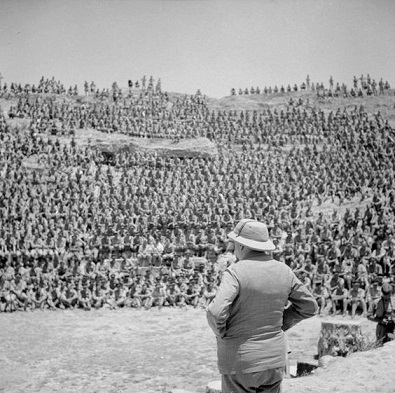
Prime Minister Winston Churchill addresses troops on the 1 June 1943 at the Roman amphitheatre at Carthage, Tunisia. The following day 7 Coy took part in lining the Gromalia road to cheer him on.
HM The King inspects a captured Tiger tank in Tunis, June 1943. On 18th June 7 Coy lined the route and was inspected by the king.
4th Division TRF
7 Field Company RE
59 Field Company RE
225 Field Company RE
18 Field Park Company RE
3 August. The 7th moved to a wet bridging camp near Bone.
10 August. Lt Roberts was attached to 21 Tank Bde to give instruction on the ‘Snake’. It was a development of the man-powered pushing of BTs through minefields from Crawley days 1941. Tanks instead of Sappers did the pushing. There appeared to be no other development of Armoured Assault Vehicles at that time which were sorely needed.
Sherman tanks of the 17th 21st Lancers in Tunisia March 1943.
Maybe these same tanks crossed the 'Amazon' bridge at Cassino, Italy.
It was the 17/21 Lancers tanks first to cross the Bailey assault bridge
code named 'Amazon' on the break-through of the 'Gustav' Line.
13 May 1944
Wireless set No 21 was used at this time
A captured Tiger tank, Tunisia 6 May 1943
Fort Gouraya, Bougie (now Bejaia). B section built winter accomodation inside for an infantry unit.
An old postcard of Bougie with Fort Gouraya in the background
HMT Llangibby Castle
7 Coy sailed from Algiers to Port Said, Egypt, December 1943
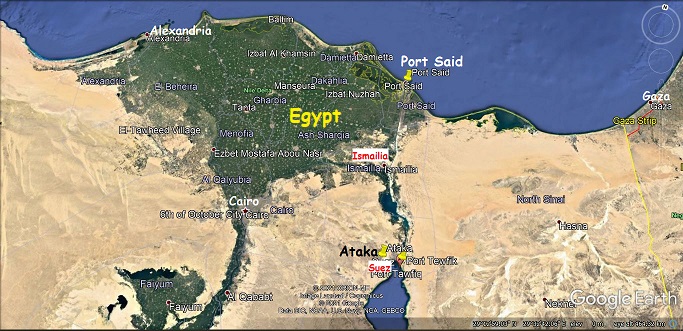
24 December Friday. ‘7’ were the last unit to disembark during the morning leaving the ship in a much better state than they found it. After a typical transit ‘wait’, the 7th eventually entrained on a 90-mile journey to the southern end of the canal on a comfortable but slow troop train. At 2300 hrs the Shiny 7 detrained at Ataka station, formed up and marched off. The OC halted the marching column precisely at midnight, turned the Company towards him and wished them a ‘Merry Christmas’ and then continued to march. The 7th found their tented camps and settled down. Great secrecy surrounded this move to Egypt. The 21 Tank Bde left the Division which became an Infantry Division once again. As a cover, it was called the 34 Division. The 28th Bde commanded by Brigadier Purvis joined the Division from Gibraltar. 2 SLI, 2 Kings and the 1st Argylls were the Bde infantry and ‘7’ would be in support of 28 Bde.
All units there continued to use their old address the 7th s address was BNAF. The Division would mount an assault on the island of Rhodes code-named operation ‘Hercules’. 10 Indian DIV would follow up after the capture to relieve the Division for duty in Italy. It was thought that a full complement of transport was not required for the operation as the enemy, 55 Motorised/Armoured German DIV of 8000 would be pinned down! By whom, it wasn’t clear. Rhodes was seen as the key to the Eastern Mediterranean, its capture would bring Turkey into the war, opening up a new warm water supply route to Russia, less savage and dangerous than the Arctic route, and at the same time relieving much shipping. In addition, the RAF Squadrons would move closer to Europe and there would be airfields within bombing range of southern Europe. The operation had an abortive history and it was eventually called off in favour of an assault directly on Sicily and the Italian peninsular.
Boxing Day Sunday. At 0700 hrs the 7th moved the odd mile nearer to mount Ataka (aptly named) next door to ‘225 Field Company RE.
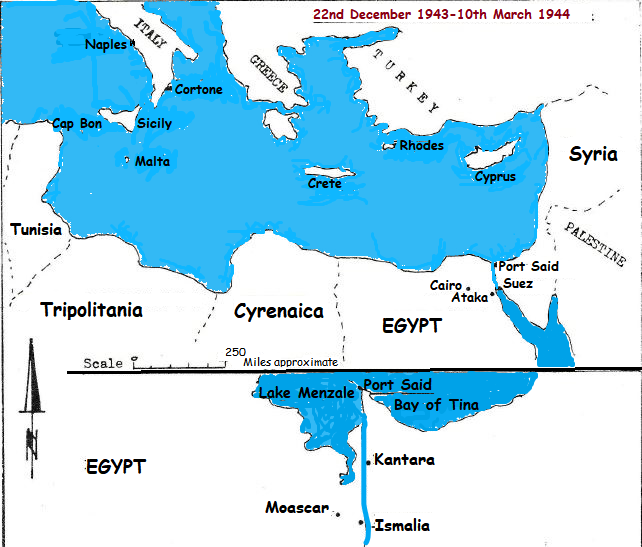
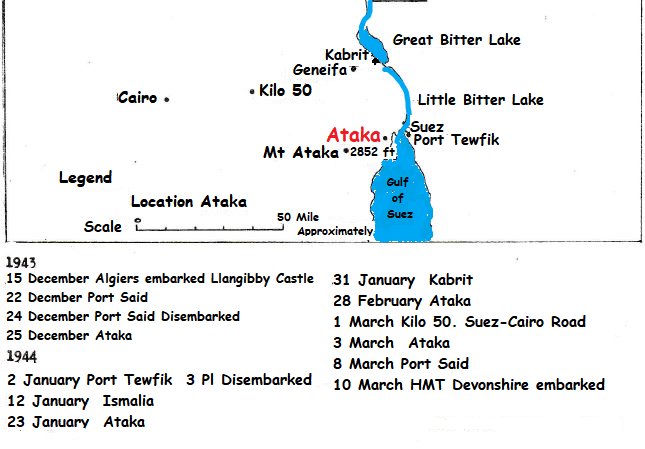
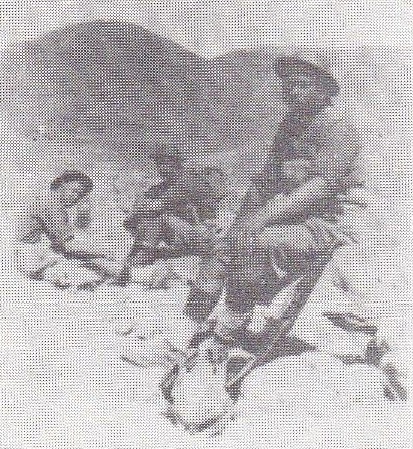
L/Sgt J Stamper taking a breather, Tunisia 1943
Photo IWM NA 2636 by Lt Whicker
With the British 1st Army on the Medjez-Tunis road at St Cyprien.
Driving past a knocked out German tank 5-7 May 1943.
A never ending stream of supplies and fighting vehicles follow up the advancing army
Lts, P, Smart, C. Blewett and L, Bocker in Egypt 1943/44
Photo credits Andrew Whyte: 7 Coy lads on a day off in Egypt visit the Pyramids.
Some identified, standing L-R Spr Shoesmith, unkown, Spr Ray Horne
Mount Ataka near 7 Field Company's location in Egypt
Lt M. Sharland, Ataka 1944
Mt Ataka in background
Photo IWM, NA 2578. The 1/4 Essex Regiment moving into action behind Churchill tanks of the First Army. Medjez-Tunis area 6 May 1943.
6
IWM NA 2304
Photo by Lt Whicker. With the First Army. A Churchill tank near Medjez El Bab.
25 April 1943
Photo IWM Collaboration with RAF Spitfires and the Eighth Army, spring 1943
An Air Force Liaison Officer (nearest camera) receiving a call from a Supermarine Spitfire about a target. The information is passed to the gunnery officer standing in the pit behind.
Photo IWM
A light Bofors gun and crew which were in action on the Goubellat Plain near Medjez-el-Bab, against enemy aircraft during operations against Tunis
Photo IWM. A 130 Ft DD Bailey bridge almost complete built by
8 Fd Sqn RE of 6 Amd Div. At Medjez El Bab. 2 January 1943
Photo IWM.
Sergeant Elms of 16/5 Lancers and his tank crew at El Aroussa; Trooper Bates, Royal Armoured Corps, Signalman Bower, Royal Corps of Signals, and Trooper Goddard, Royal Armoured Corps, clean the 6-pounder gun of their Crusader tank while preparing for the drive on Tunis.
British First Army Formation Badge
V Corps TRF
IX Corps TRF
4th Division's route with V Corps & IX Corps, April-May 1943
7 Field Company's Locations 7 May - 1 July 1943
Photo IWM. NA 1444
NA 1444. Water Supply for the First Army
A water point on the Teboursouk-Testour Road. (west of Medjez El Bab)
the Autominor is working beneath the tree on the right. In the foreground a truck is filling up.
Taken by Sgt Weber. 23.3.43
Testing a No 21 wireless set while out on experimental patrol Tunisia 1943
Photo IWM
IWM Photo NA 1443. Water Supply for the First Army
Patterson trailer - mounted water purification set. (Autominor) working beside a stream near Teboursouk. In the field behind, is the water supply point with a truck on the road receiving fresh water supplies.
Taken by Sgt Weber 23.3.43.
Photo IWM NA 1443
Issued Compo cigarettes at the time
From May 43, 7 Field Company was periodically involved with water supply and maintenance for several months
Lts C Blewett and A. Hobson.
Lt Hobson joined the Company in February 44 at Ataka
Pages will be updated as new material becomes available.
Comments to: georgecowie103@yahoo.co.uk
British Army water bottle
Bangelore Torpedoes
Bren Gun
Compo Boiled Sweets
Sections used bayonets as mine prodders and some of the men preferred them to
the specially made prodders that were introduced later in 1944






